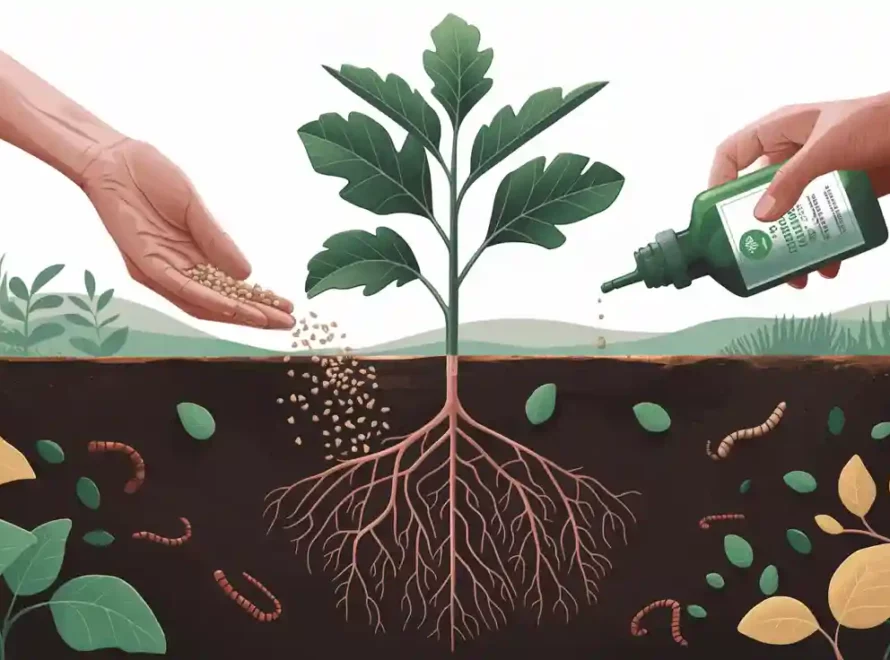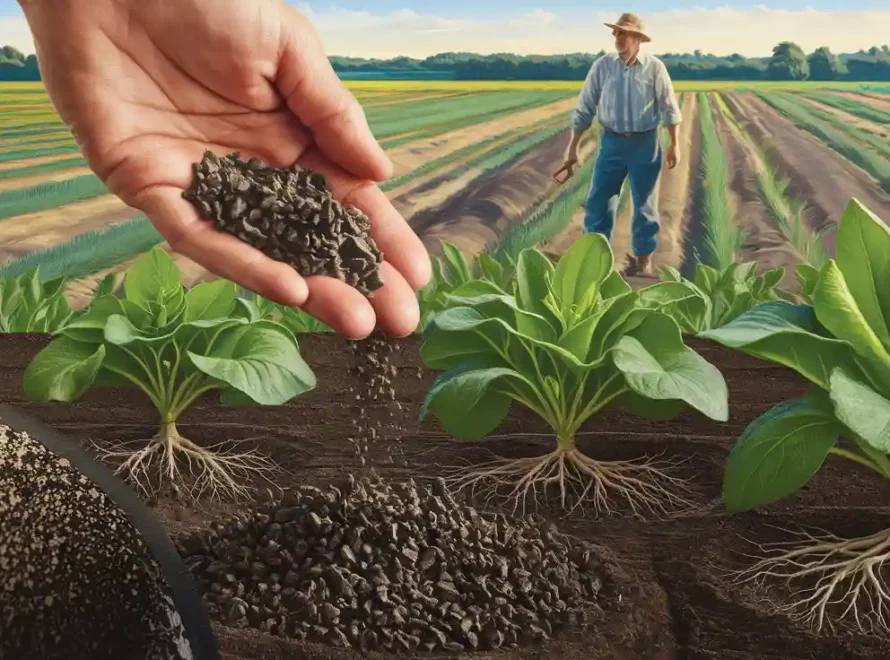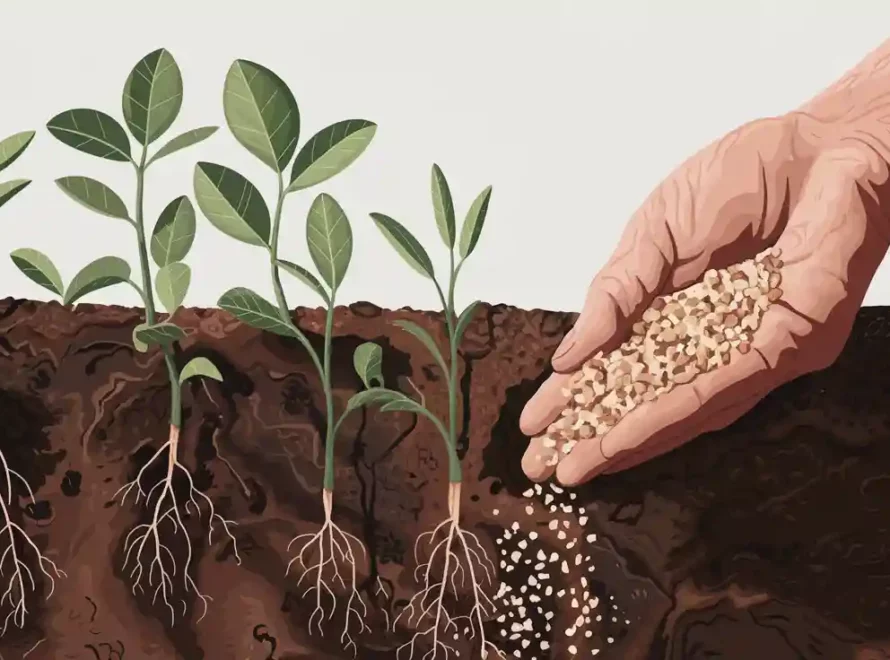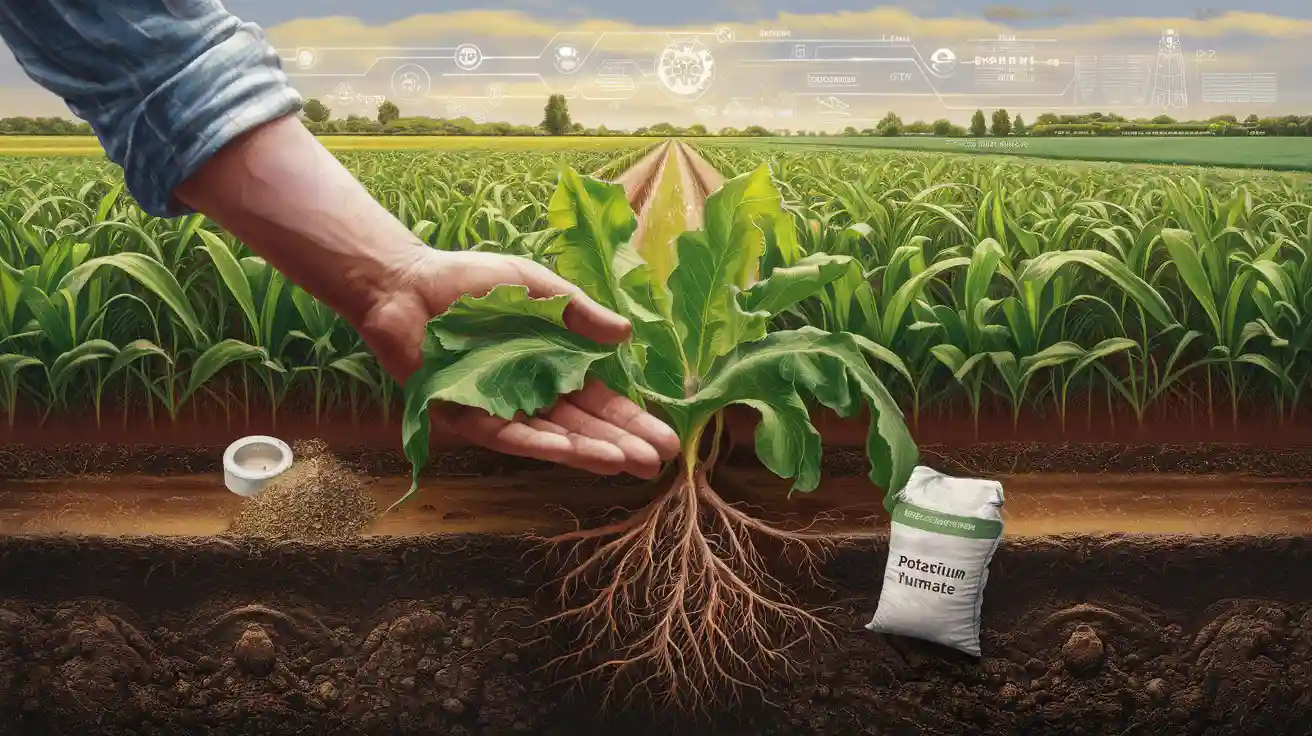
Is potassium humate fertilizer the key to sustainable crop production in 2025? I believe so. Scientific studies show it increases crop yield, soil health, and stress resistance. For example, foxtail millet trials revealed higher plant height, chlorophyll, and grain yield. Southland Organics’ Humate, sourced from a rare Georgia deposit, delivers a unique blend of humic acids and beneficial microbes.
| Aspect | Trends 2020-2024 | Projections 2025-2035 |
|---|---|---|
| Industry Adoption | Organic farming growth | AI-driven precision, regenerative soil management |
| Sustainability | Eco-friendly packaging, low emissions | Zero-waste, AI resource efficiency, regenerative soils |
Farmers need effective tools now. I see potassium humate fertilizer driving real change.
- Potassium humate fertilizer improves soil structure, fertility, and microbial activity, leading to healthier and more productive soil.
- Using potassium humate boosts crop yields by enhancing nutrient uptake, root growth, and plant vigor, even under stress conditions like drought.
- Southland Organics’ Humate contains a unique blend of humic acids and beneficial microbes sourced from a rare Georgia deposit, offering superior soil and crop benefits.
- Applying potassium humate at the right dosage and timing maximizes its effectiveness; regular soil testing helps tailor applications for best results.
- Potassium humate works better than many chemical fertilizers and organic amendments by improving soil health and reducing environmental impact.
- This fertilizer supports sustainable farming by increasing carbon sequestration, reducing water use, and lowering greenhouse gas emissions.
- Real-world studies and farmer experiences confirm potassium humate’s ability to increase crop quality, yield, and stress resistance.
- Integrating potassium humate into your soil management program builds resilient soils and promotes long-term agricultural success.
Potassium Humate Fertilizer Benefits
Soil Health
Structure
I have seen firsthand how potassium humate fertilizer transforms soil structure. When I apply it to my fields, the soil becomes more crumbly and easier to work. Scientific studies back up my experience. For example:
- A three-year peanut crop experiment showed that potassium humate fertilizer improves soil properties and increases microbial diversity. This leads to better soil structure and supports sustainable farming.
- In Brazil, coffee plantations using potassium humate fertilizer saw a 20% yield increase. Improved soil structure and nutrient retention made this possible.
- Research in India on rice cultivation found a 15% harvest increase, thanks to better root development and nutrient uptake.
Southland Organics’ Humate stands out because it comes from a rare, carbon-rich deposit in Georgia. This unique source preserves the natural balance of marine and plant carbon compounds. The result is a product that enhances soil aggregation, increases porosity, and boosts water retention. I notice my soil holds moisture longer and resists compaction, which helps my crops thrive.
Fertility
Soil fertility is the foundation of healthy crops. I rely on potassium humate fertilizer to unlock nutrients in my soil. On-farm trials on alluvial soils have shown that using potassium humate fertilizer with other fertilizers can raise rice yields to nearly 7 tons per hectare. These trials also found that potassium humate fertilizer reduces soil acidity, increases pH, and raises levels of nitrogen, phosphorus, and organic matter.
Southland Organics’ Humate contains a balanced mix of essential nutrients—nitrogen, phosphorus, potassium, calcium, magnesium, and trace minerals. These nutrients are in forms that plants can absorb easily. The humic and fulvic acids in Humate help bind nutrients to soil particles, preventing them from washing away. This means my crops get a steady supply of what they need, and I see stronger, healthier plants as a result.
Microbial Activity
Healthy soil teems with life. I want my fields to support a diverse and active microbial community. Potassium humate fertilizer provides carbon and energy sources that feed beneficial bacteria and fungi. These microbes break down organic matter, release nutrients, and protect plants from disease.
- Potassium humate fertilizer increases microbial biomass and supports resilience against pathogens.
- It improves soil chemical properties, such as cation exchange capacity, which boosts nutrient retention by up to 50%.
- Application of potassium humate fertilizer raises soil pH and organic matter content, accelerating decomposition and humus formation.
Southland Organics’ Humate goes a step further by adding living microbes to the mix. These microbes help decompose pesticide residues, unlock bound nutrients, and break up compacted clay soils. I have noticed that my soil smells richer and looks darker after regular use, a clear sign of increased microbial activity.
Crop Yield
I measure success by the harvest. Potassium humate fertilizer consistently delivers higher yields for me and many other growers. It enhances nutrient availability and uptake, leading to better root development and overall plant health. I have seen improved water retention in my soil, which helps my crops survive dry spells.
- Potassium humate fertilizer triggers the synthesis of enzymes and hormones that promote flowering and fruit set.
- Combining it with NPK fertilizers increases nutrient efficiency and boosts productivity.
- Seed dressing and soil application methods with potassium humate fertilizer increase germination rates and early seedling vigor.
Scientific studies confirm these results. For example, treated plants show up to 30% better nutrient uptake and stronger root systems. I have observed that my crops not only yield more but also produce higher quality harvests, with better size, color, and taste.
Stress Resistance
Modern farming faces many challenges, from drought to soil salinity. I trust potassium humate fertilizer to help my crops withstand these stresses. Research on maize shows that foliar application of potassium humate fertilizer, especially when combined with chitosan, improves drought resistance. Plants absorb nutrients more efficiently, retain more water, and maintain higher yields even under limited irrigation.
A pot experiment on eggplant under water deficit stress found that potassium humate fertilizer activates antioxidative defense systems and enhances water-use efficiency. It acts like a natural hormone, stimulating photosynthesis and nutrient uptake. I have seen my plants stay green and vigorous during dry periods, thanks to the improved soil fertility and water-holding capacity provided by Southland Organics’ Humate.
Tip: I recommend using Southland Organics’ Humate as part of a regular soil management program. Its unique blend of humic acids, fulvic acids, and beneficial microbes offers a powerful, natural way to build resilient soils and boost crop performance.
What Is Potassium Humate?
Definition
When I talk about potassium humate, I refer to a powerful soil amendment derived from natural sources like brown coal or ancient organic deposits. This substance contains a rich blend of humic substances, including humic acid, fulvic acid, and humin. I see potassium humate as more than just an additive. It acts as a catalyst for soil health and plant growth. Its unique physio-biochemical properties help plants thrive, especially under tough conditions like drought or high salinity. By applying potassium humate, I notice improved enzyme activity, better nutrient uptake, and stronger plant tolerance to water stress. It works much like a natural hormone, activating photosynthesis and increasing the permeability of plant cell membranes. When I combine it with other soil amendments, such as biochar, I observe even greater improvements in plant growth, yield, and quality.
Composition
The composition of potassium humate fertilizer sets it apart from other soil amendments. It contains:
- Humic acids and fulvic acids, which are essential for soil fertility and plant health.
- A balanced mix of nutrients, including nitrogen, phosphorus, potassium, calcium, magnesium, and trace minerals.
- Plant growth regulators like auxins and cytokinins, which stimulate root and shoot development.
- Proteins and amino acids that support plant metabolism and resilience.
Advanced techniques like dynamic light scattering and high-performance size exclusion chromatography reveal that potassium humate has a complex molecular structure. This structure allows it to form stable complexes with soil particles, improving soil aggregate stability and water retention. I have seen how these properties help protect soil from erosion and disaggregation, making it more productive over time. The chemical profile of potassium humate also includes hydrophobic components that create water-repellent coatings, further enhancing soil structure.
How It Works
I rely on potassium humate fertilizer because of the way it interacts with soil and plants. Here’s how it works:
- Acts as a natural chelating agent, making nutrients like nitrogen, phosphorus, and potassium more available to plants.
- Improves nutrient solubility and retention, reducing leaching and increasing fertilizer efficiency.
- Enhances soil structure and water retention, supporting deeper root growth and better drought tolerance.
- Stimulates microbial activity, which promotes nutrient cycling and organic matter breakdown.
- Increases cation exchange capacity, allowing soil to hold and exchange more nutrients.
- Buffers soil pH, keeping it in the optimal range for nutrient uptake.
- Encourages carbon sequestration, supporting sustainable farming practices.
When I use potassium humate fertilizer, I see healthier root systems, improved nutrient uptake, and greater resistance to pests and diseases. Different formulations, such as liquid or granular, offer flexibility for various crops and soil types. Regular application, combined with soil testing, helps me maximize these benefits and achieve sustainable crop production.
Application Methods
Dosage
I always start by calculating the right dosage for my crops and soil. The amount of potassium humate fertilizer I use depends on the crop type, soil condition, and growth stage. I rely on research-backed guidelines to avoid over-application and ensure the best results. Here’s a table I use to guide my decisions:
| Crop Type | Dosage (lbs/acre) | Foliar Spray Dilution | Notes |
|---|---|---|---|
| Leafy Greens | 1-2 | 1-2% | Use lower end for sandy soils |
| Fruiting Plants | 2-4 | 1-2% | Increase for clay soils |
| Root Vegetables | 3-5 | 1-2% | Monitor soil pH (6.0-7.5 optimal) |
For seed dressing, I apply up to 200 mL per kg of seed, which improves germination and early growth. When I use soil application, I find that 20 L per hectare works best. Higher rates, like 30 L/ha, can actually reduce productivity, so I avoid exceeding recommended levels. I always monitor plant response and adjust as needed.
Tip: Regular soil testing helps me fine-tune the dosage for each field.
Timing
I have learned that timing is just as important as dosage. I apply potassium humate fertilizer at planting or during critical growth phases. For example, I use a basal soil application before sowing, then follow up with foliar sprays at key stages—such as 25 and 40 days after sowing for crops like Chinese cabbage. This split application strategy matches nutrient availability with the plant’s needs, leading to better growth and yield. I also notice that applying humate during periods of rapid root or shoot development gives the best results.
Techniques
Field Crops
For my field crops, I use several techniques to maximize the benefits of potassium humate fertilizer:
- Soil Amendment: I mix granular or flake humate into the soil before planting. This improves aeration and water retention.
- Foliar Spray: I apply a diluted solution directly to the leaves during active growth. This method provides quick nutrient absorption.
- Combined Use: I often combine humate with other organic or synthetic fertilizers to enhance nutrient chelation and availability.
Southland Organics offers products like Genesis Humate Soil Conditioner and Jump Start Liquid Soil Conditioner, which I find effective for large-scale applications.
Gardens
In my garden beds, I prefer liquid humate for easy mixing and even coverage. I use a watering can or hose-end sprayer to apply the solution around the base of plants. I focus on early growth stages and flowering periods for the best impact. For raised beds, I sometimes blend granular humate into the soil at the start of the season.
Lawns
For lawns, I use Revival Liquid Lawn Aerator from Southland Organics. I apply it with a hose-end sprayer, covering the entire area evenly. I repeat the application every 4-6 weeks during the growing season. This keeps my grass green, healthy, and resilient against drought and foot traffic.
Note: I always check the product label for specific instructions and adjust my approach based on local soil and climate conditions.
Crop Yield & Quality
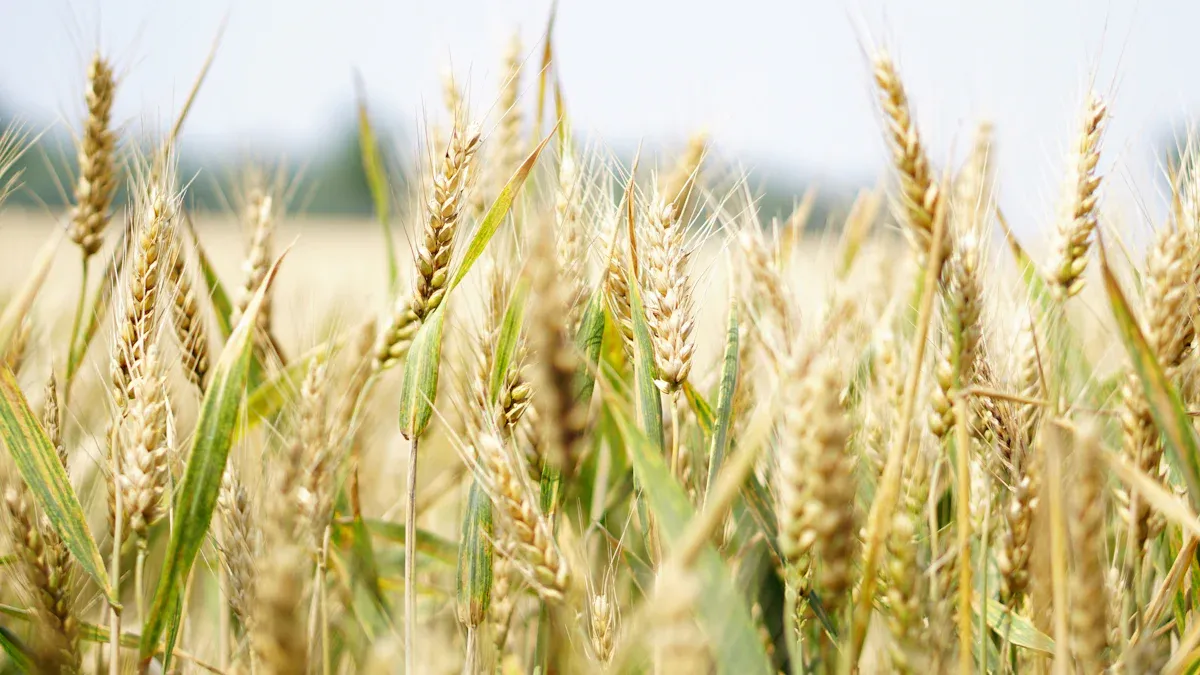
Nutrient Uptake
I always look for ways to help my crops absorb nutrients more efficiently. When I apply humate-based products, I notice a clear improvement in nutrient uptake. The humic and fulvic acids in Southland Organics’ Humate act as natural chelators. They bind essential nutrients like nitrogen, phosphorus, and potassium, making them more available to plant roots. This process helps my crops get the nutrition they need, even in soils that tend to lock up nutrients. I see greener leaves, stronger stems, and more uniform growth across my fields. Improved cation exchange capacity in the soil means nutrients stay where plants can use them, not lost to runoff or leaching. I have found that maintaining soil pH between 6.0 and 7.5, along with regular humate applications, optimizes nutrient availability and supports healthy plant development.
Root Growth
Healthy roots are the foundation of a productive crop. I have seen firsthand how potassium humate fertilizer encourages deeper, stronger root systems. Research on carrot plants shows that humate applications increase root length and fresh weight, especially under water stress. These improvements come from better soil water retention and enhanced organic acid exudation by roots. In my own fields, I observe that crops treated with humate develop thicker, more fibrous roots. This allows them to access water and nutrients from deeper in the soil profile. During dry spells, these robust roots help my plants stay healthy and productive. I also notice that combining humate with potassium sulfate can further boost root growth and yield, particularly when irrigation is limited.
Plant Vigor
Vigorous plants resist stress and produce higher yields. I rely on humate products to boost overall plant health and resilience. Here’s what I have learned from both research and experience:
- Humate improves soil structure and supports beneficial microbes, which are vital for nutrient uptake.
- It increases root mass by up to 30%, giving plants a stronger anchor and better access to resources.
- The chelation process makes nutrients more available, leading to faster growth and better fruit set.
- Application rates of 2-4 pounds per 100 square feet during key growth stages maximize these benefits.
- Humate enhances soil moisture retention, helping plants thrive during dry periods.
- It raises soil cation exchange capacity, improving nutrient retention and reducing fertilizer waste.
- Improved soil porosity and air circulation support deeper root penetration and overall plant vigor.
I have seen my crops grow taller, with thicker stems and more robust foliage. Treated plants show higher sugar and chlorophyll content, which means better photosynthesis and stronger disease resistance. Even during challenging weather, my fields remain lush and productive. For me, humate is an essential tool for building resilient, high-yielding crops.
Potassium Humate Fertilizer vs Others
Chemical Fertilizers
When I compare my results with chemical fertilizers to those with humate-based products, I see clear differences. Chemical fertilizers provide nutrients quickly, but they often fail to improve soil structure or long-term fertility. In my fields, I notice that repeated chemical fertilizer use can lead to soil compaction and reduced microbial activity. When I add humate to my fertilizer program, I see healthier plants and better yields.
A field experiment on bread wheat showed that combining potassium humate with nitrogen fertilizer increased grain yield by almost 28% and straw yield by 16% compared to nitrogen alone. The plants also used nitrogen more efficiently, and the grain had higher protein content. In potato crops, humic acid-containing fertilizers boosted plant height by over 24% and dry matter by more than 55% compared to chemical fertilizers alone. These results match what I see in my own fields—stronger growth, higher yields, and better crop quality.
Here is a comparison table that summarizes the differences:
| Aspect | Potassium Humate + NPK | Traditional NPK Fertilizers |
|---|---|---|
| Soil acidification mitigation | Significant | Less effective |
| Water-stable aggregates | Increased | Lower |
| Water-soluble phosphate content | Higher | Lower |
| Soil biological activity | Highest | Lower |
| Crop yield | Superior | Lower |
I also notice that humate improves soil aeration and reduces compaction, which chemical fertilizers do not address. My crops become more resilient to stress, and the soil stays productive year after year.
Organic Amendments
I have used many organic amendments, such as compost and raw humic acid, to improve my soil. While these products help, I find that potassium humate offers unique advantages. Unlike raw humic acid, which is poorly soluble and slow to act, potassium humate dissolves easily in water and works quickly. This means I see results faster, especially in potassium-deficient soils.
The following table highlights the differences:
| Aspect | Humic Acid | Potassium Humate |
|---|---|---|
| Solubility | Poor | Excellent |
| Action Speed | Gradual | Immediate |
| Nutrient Role | General enhancer | Growth stimulant |
| Soil Impact | Improves structure | Boosts fertility, CEC |
| Stress Tolerance | General | High |
| Microbial Biomass | Moderate | Up to 50% increase |
| Aggregate Stability | N/A | +30% |
| Nitrate Leaching | N/A | -25% |
| Application Methods | Soil only | Soil, irrigation, foliar |
I see that potassium humate increases microbial biomass by up to 50% and improves soil aggregate stability by almost 30%. It also reduces nitrate leaching, which helps protect water quality. I can apply it in more ways, including through irrigation and foliar sprays, making it versatile for different crops and systems.
Sustainability
Sustainability matters to me as a grower. I want to build soil health, reduce environmental impact, and use resources wisely. Potassium humate supports these goals better than traditional agrochemicals. Studies show that it increases carbon sequestration by about 13% and improves water-holding capacity by 10%. I have seen my fields require less irrigation, which saves water and money.
Here is a summary of key sustainability metrics:
| Sustainability Metric | Potassium Humate vs. Agrochemicals |
|---|---|
| Carbon Sequestration | +13% |
| Water-Holding Capacity | +10% |
| Greenhouse Gas Emissions | -260 kg CO₂ eq./ton cane |
| Nutrient Uptake (N, P, K) | Significantly enhanced |
| Nutrient Use Efficiency | Improved |
| Soil Microbial Activity | Enhanced |
| Soil pH Balance | Improved |
| Soil Aeration | Better |
| Agrochemical Use | Reduced |
| Water Requirement | -21 m³/ton cane |
I see that using humate-based products leads to healthier soils, lower greenhouse gas emissions, and less pollution. My crops grow stronger, and I feel confident that I am farming in a way that protects the land for future generations.
Real-World Results
Case Studies
I have seen the impact of humate-based products in real-world farming. Several case studies stand out to me:
- Over two growing seasons, researchers tested potassium humate with chelated zinc in maize fields using advanced irrigation methods. They found that maize grain yield and irrigation water use efficiency improved, especially under deficit irrigation paired with alternate partial root-zone irrigation.
- The combination of potassium humate and zinc increased nutrient uptake, including nitrogen, phosphorus, potassium, magnesium, zinc, and iron. Fixed partial root-zone irrigation helped maize plants manage drought stress by boosting phosphorus uptake by 53.8%, potassium by 59.2%, proline by 74.4%, and catalase by 75% compared to untreated controls.
- Antioxidant enzyme activities, such as superoxide dismutase, peroxidase, and catalase, rose significantly with these treatments. This improved the plants’ defense systems during drought.
I have also read about tomato growers who reported higher yields and better fruit quality after using humate products. Corn and grape producers documented yield increases of 30% and 25%, respectively, with healthier plants and improved soil structure.
Scientific Evidence
Peer-reviewed research confirms what I see in the field. For example, studies show that humate applications help peanuts tolerate water stress by regulating proline and antioxidant enzymes. Faba bean crops grown in newly reclaimed soils produced higher yields and showed better physiological traits when treated with humate. In sandy soils, humate solutions increased phosphorus availability, which is vital for plant growth.
Researchers found that combining humate with cobalt helped groundnut crops overcome water stress during sensitive growth stages. In calcareous soils, maize yields and nutrient uptake improved with humate use. Tomato plants treated with humate grew stronger, produced more fruit, and had better nutritional status. Reviews highlight potassium’s role in helping plants handle stress, supporting the use of potassium-rich humate products.
Environmental Impact
I care deeply about the environment and want my farming practices to support sustainability. Humate-based products help me achieve this goal. They improve soil water retention and reduce compaction, which means I use less irrigation and protect soil structure. I have seen healthier root systems and more active soil microbes, which leads to better nutrient cycling and less need for chemical fertilizers.
Farmers using humate products have reported a 20% rise in tomato production, a 30% increase in corn yields, and improved fruit quality in grapes and carrots. These results show that humate not only boosts crop performance but also supports long-term soil health and environmental stewardship.
I have seen how Southland Organics’ Humate transforms soil health and crop yield. Its unique blend of humic acids and beneficial microbes supports sustainable agriculture. For best results, I recommend these steps:
- Apply humate directly to the root zone for maximum plant benefit.
- Combine with controlled-release potassium fertilizers to boost nutrient efficiency.
- Integrate with beneficial soil microbes to enhance productivity.
- Use regularly to improve soil fertility and microbial diversity.
Sustainable farming starts with healthy soil. I trust humate to deliver lasting results.
FAQ
What crops benefit most from potassium humate fertilizer?
I have used potassium humate on vegetables, grains, fruit trees, and lawns. I see the best results in crops that need strong root systems and high nutrient uptake, such as tomatoes, corn, wheat, and leafy greens.
How often should I apply Southland Organics’ Humate?
I apply Humate every 4 to 6 weeks during the growing season. For best results, I follow the product label and adjust based on crop type and soil condition.
Can I mix potassium humate with other fertilizers?
Yes, I often combine potassium humate with NPK or organic fertilizers. This practice improves nutrient efficiency and supports better plant growth. I always check compatibility before mixing.
Is potassium humate safe for organic farming?
I trust Southland Organics’ Humate for my organic fields. The product contains only natural ingredients and beneficial microbes. It meets organic standards and supports sustainable agriculture.
Will potassium humate help with drought or poor soil?
I rely on potassium humate to improve water retention and soil structure. My crops show better drought resistance and root growth, even in sandy or compacted soils.
How do I store Southland Organics’ Humate products?
I keep Humate in a cool, dry place away from direct sunlight. I make sure the container stays sealed to preserve the living microbes and organic acids.
Can I use Humate on my lawn or garden?
Absolutely! I use Southland Organics’ Humate on my lawn and garden beds. It keeps my grass green and my vegetables healthy. I follow the recommended rates for best results.
What makes Southland Organics’ Humate different from other humate products?
Southland Organics’ Humate comes from a unique Georgia deposit. It contains a balanced mix of marine and plant carbon, essential nutrients, and living microbes. I see faster results and healthier soil compared to other products.

